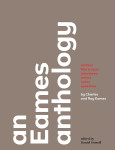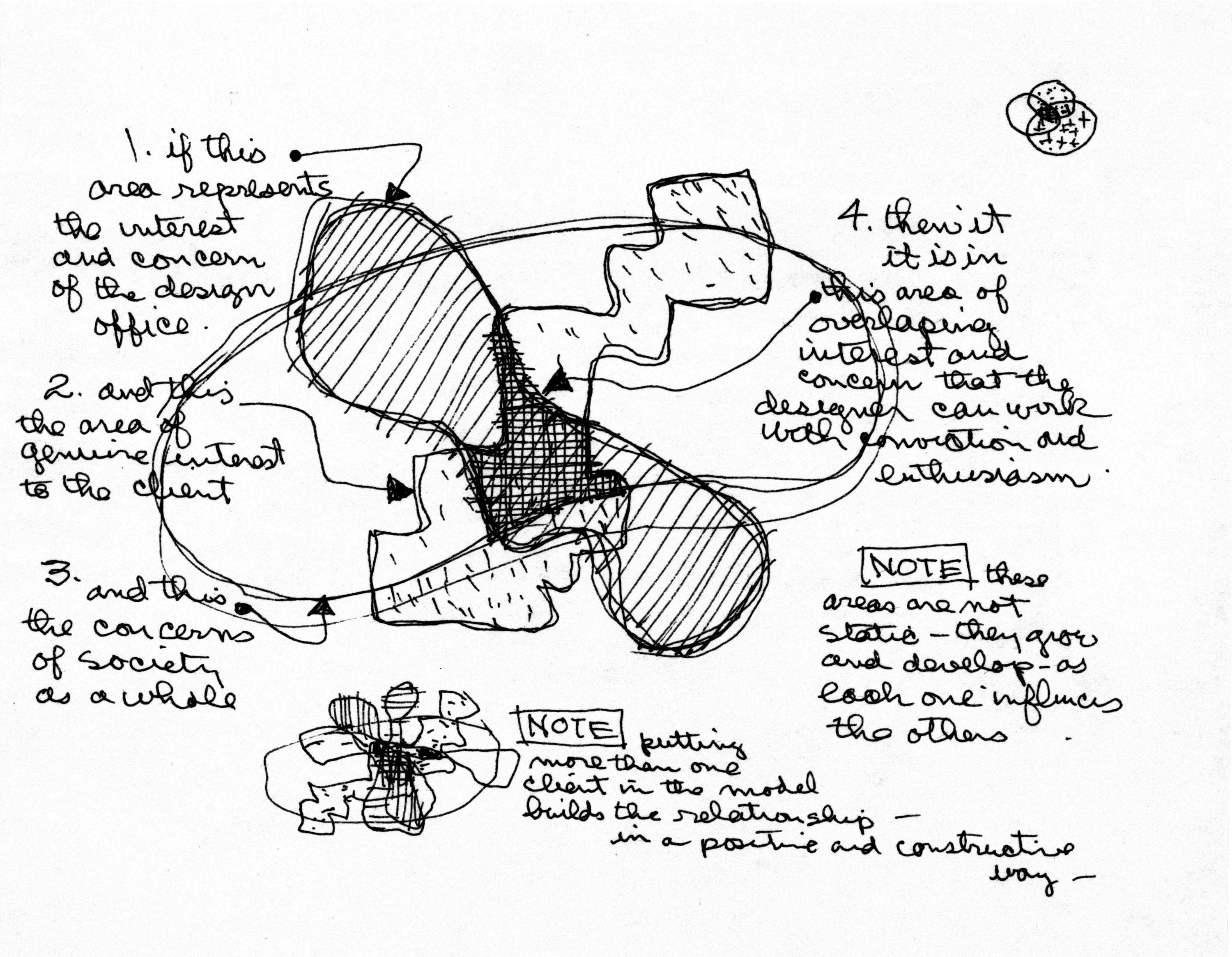An Interview with Daniel Ostroff, Editor of An Eames Anthology
Ivy Sanders Schneider–
American designers Charles and Ray Eames first began their collaboration in the early 1940s and continued to join creative forces – producing furniture, films, and architectural works – until Charles’ death in 1978. Although their earliest designs were conceptualized nearly 75 years ago, they feel as current now as they did then – airports around the country are still filled with banks of their leather and aluminum tandem seats, and homes and offices around the world boast their 1956 Lounge Chair & Ottoman.
Thanks to the Eames Office and Daniel Ostroff, editor of our just-released book An Eames Anthology: Articles, Film Scripts, Interviews, Letters, Notes, and Speeches, we’ve had the opportunity this spring to share the Eameses in a new way: through their profound and prolific writing.
In a recent email exchange, Daniel Ostroff shared his thoughts on the Eames’ legacy, the applicability of their design process to all areas of life including film-making, and his own process in compiling this seminal volume. Here’s part one of the interview; stay tuned for part two. And check out our ongoing contest to win a copy of the book.
Ivy Sanders Schneider: I’d like to start by asking you about your experience assembling the Eames Anthology. What initially drew you to Charles and Ray Eames as subjects?
Daniel Ostroff: The applicability of their ideas to the problems of today and tomorrow; they gave practical advice that all of us can use daily.
ISS: You mention in the book’s acknowledgements that essays by Ralph Caplan influenced you to compile this anthology, but what in his texts specifically provoked or inspired you?
DO: This speaks to my point about the book being useful for everyone. I am a film producer now; I began my career as a Hollywood agent. When I opened my own office, an artist friend visited and expressed dismay at seeing rented furniture. When I asked him how I should furnish the place, he asked, “Why buy furniture that depreciates in value?” Pretty soon, instead of decorating my agency in a traditional fashion, I curated a collection of furniture. That collection started with a vintage Eames desk. To learn more about the designs that appealed to me I started reading books, and reading Ralph’s Connections: The Work of Charles and Ray Eames was transformative.
I used two Eames quotes I encountered in Connections in what I called “the Eames talk,” which I gave to all of my writer and director clients. The first was this one, from Charles Eames:
“How do you design a chair for acceptance by another person? By not thinking of what the other guy wants, but by coming to terms with the fact that while we may think we are different from other people in some ways at some moments, the fact of the matter is that we’re a hell of a lot more like each other than we’re different, and that we’re certainly more like each other than we’re like a tree or a stone. So then you relax back into the position of trying to satisfy yourself—except for a real trap, that is, what part of yourself do you try to satisfy? The trap is that if you try to satisfy your idiosyncrasies, those little things on the surface, you’re dead, because it is in those idiosyncrasies that you’re different from other people.”
The way you design a film, I explained to my clients, can be looked at the same way, as a problem to solve. Look at the movie Braveheart. I admire the fact that the screenwriter did not begin by attempting to connect the audience to the main character – a medieval Scottish freedom fighter named William Wallace – based on characteristics that would highlight the differences between Wallace and the audience of moviegoers. Instead, the audience is asked to view Wallace as a familiar figure: he is first seen as a young child, as a son and as a brother, and later, as a groom on his wedding day. To craft a story with this intention of connecting with the largest number of people is a form of problem-solving, and Charles and Ray approached the practice of design as problem solving. This Eames lesson was applicable to storytelling, my day job then and now, and to other endeavors.
The second Eames quote I used in my Eames talk was actually a distillation of their design process diagram.
The Eames process showed me a way forward. Because the movie business aspires to bring quality stories to the widest possible audience, I thought the ideas of people who wanted to “bring the best to the most for the least amount of money” could guide me and others.
ISS: Scholars often speak to the Eames’ use of constraints to improve their designs. With such a large volume of source material, what constraints did you impose upon yourself to create this volume and how did you go about curating this book?
DO: I had several guiding principles; two of the most important were: 1. Make a single volume. In this book, readers get their first exposure to Charles and Ray’s writings, and I wanted this exposure to be as accessible and broadly appealing as possible. The “Complete Writings” would need to be a multi-volume set. 2. Select the texts that are most “useful” to contemporary and future readers. I gave my agent, Jennifer Lyons, the manuscript inside a tool box, and asked her to submit it to Yale University Press that way. The message was, “these texts are tools.” I didn’t want this to be a history book. I selected texts that provide lessons and examples that are useful to us today, and will be useful tomorrow.
ISS: How did your process in assembling an anthology differ from exploring Charles and Ray Eames through other media such as exhibitions and film?
DO: I am an avid reader; reading for me is the best way to absorb ideas. Among the writings included in An Eames Anthology are many scripts from their films, because the words and ideas in their narrations and scripts are often some of their most important statements. When you watch a film, you can get distracted by the beautiful moving images. When you read the text of their film about their Compact Sofa, it becomes clear that when Charles and Ray undertook to design a sofa, they considered, first and foremost, the problems of shipping. Isn’t that marvelous? These texts enhance our understanding of their designs, most of which, like the sofa, are still being produced, and are still popular. The way the Eames Compact Sofa looks is a result of the designers’ consideration of everything: that a sofa with reduced volume would work well in a variety of spaces, and that it could be flat-packed (another Eames first: the first flat-packed sofa!) and thus less expensive; and finally, great comfort. Ralph Caplan wrote, “the Eames approach to chairs (and to anything else) is an approach we can bring to activities more important than taking the weight off one’s feet.” These texts illuminate their practical approach to filmmaking, architecture, toys, graphic design, and to the curating of exhibitions.
ISS: How did you approach presenting, in this two-dimensional medium, elements of the Eames’ spacial or temporal work – their films, their furniture, and their toys?
DO: The best example of this may be Charles Eames’s “Arboretum Speech.” As with many of his speeches, Charles presented slides to the audience, and commented on the slides. Charles and Ray loved the György Kepes phrase, “the language of vision” and they put this into practice with carefully arranged slide shows. From the many speeches for which Charles used slide shows, I picked the Arboretum speech as representative. This speech also contains some unique ideas, which are not found elsewhere. With the help of the experienced Eames Office archivist, David Hertsgaard, I was able to locate many of the slides, and by carefully working things out with YUP’s super sensitive editor, Heidi Downey, and the talented and disciplined book designer, Mark Thomson, we present the slides alongside the comments that Charles made to the audience in the auditorium. In that chapter, you get in a reading experience something approximating the experience of attending that lecture and hearing Charles talk about each slide.
If you live in southern California, you have the good fortune to be able to see and hear Daniel Ostroff talk about Charles and Ray Eames:
Wednesday, May 13th, 6-8pm at the Pasadena Design Within Reach (rsvp required)
Saturday, May 23rd from 5-7 at the Neutra Research House
Tuesday, May 28th, 6:30pm at UCLA’s Royce Hall (rsvp required)
Daniel Ostroff is the author of Modern Classic, Eames + Valastro, and Collecting Eames. He was consulting curator for Eames Words and curator of Collecting Eames: The JF Chen Collection, both for The Getty Museum’s Pacific Standard Time Consortium. He has consulted for The Eames Office, The Museum of California Design, Herman Miller, LACMA and SFMoMA, and others. Ostroff also produces feature films, television, and documentaries.
Ivy Sanders Schneider, a rising junior English major in Yale College, is an art & architecture intern at Yale University Press.























